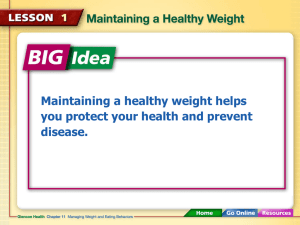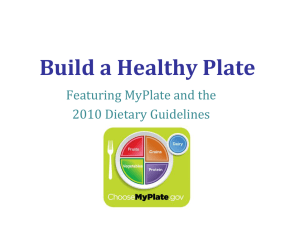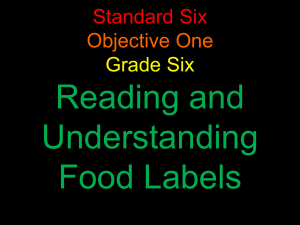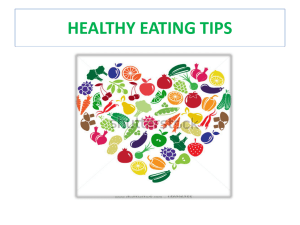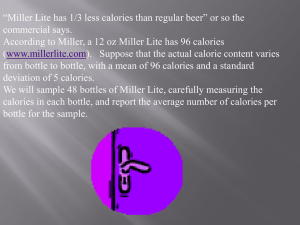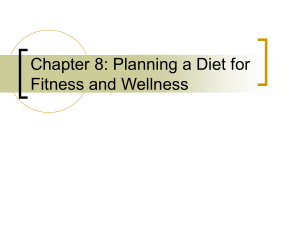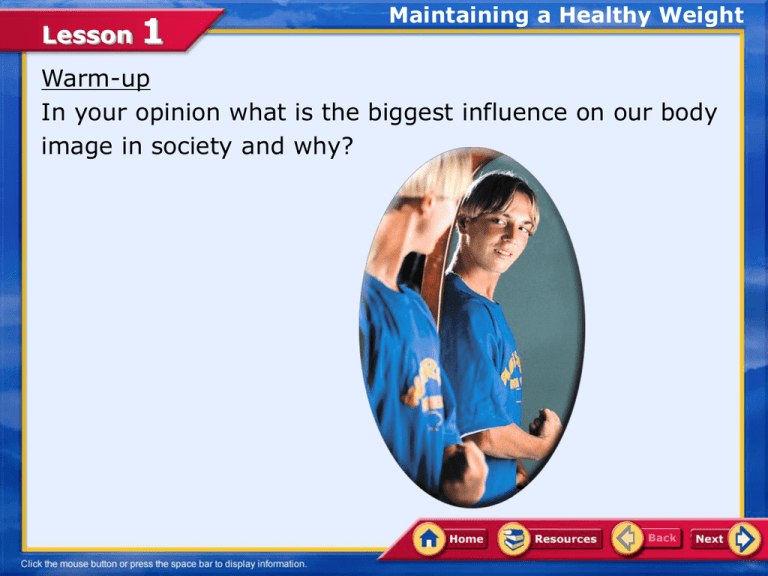
Lesson
1
Maintaining a Healthy Weight
Warm-up
In your opinion what is the biggest influence on our body
image in society and why?
Lesson
1
Maintaining a Healthy Weight
For many people, body image is tied
to perception of weight.
Your own healthy weight probably
won’t be the same as your
best friend’s.
Lesson
1
Lesson Objectives
In this lesson, you will learn to:
• Associate the relationships between body composition,
diet, and fitness
• Describe the importance of maintaining a healthy weight
to promote health and prevent disease
• Demonstrate healthful ways to manage weight
Lesson
1
The Weight-Calorie Connection
Maintaining a Healthy Weight
Calories are units used to measure:
• Energy in food.
• Energy your body uses for life processes and physical
activities.
Maintaining a healthy weight is a matter of energy balance. The
calories you consume must equal the calories your body burns.
Lesson
1
Calculate Your Needs
•
Women:
65 + (4.3 x weight in pounds) + (4.7 x height in inches) - (4.7 x age in years)
•
Men:
66 + (6.3 x weight in pounds) + (12.9 x height in inches) - (6.8 x age in years)
• Mr. Peifer
•
66+(6.3x205)+12.9 x 70) – (6.8 x 23)= 2259.22 Calories
Lesson
1
The Weight-Calorie Connection
Calories: Their Source
The specific number of calories in a food depends on:
• Portion size.
• The amounts of carbohydrates, proteins, and fats in the food.
• How the food is prepared or cooked.
Lesson
1
The Weight-Calorie Connection
The Energy Equation
Tipping the balance of the energy equation will result in weight
loss or gain.
If you take in fewer
calories than you burn,
you lose weight.
If you take in more
calories than you burn,
you gain weight.
Lesson
1
Determining Your Appropriate Weight Range
Factors Influencing Your Appropriate Weight
• Gender
• Age
• Height
• Body frame
• Growth rate
• Metabolic rate
• Activity level
Lesson
1
Determining Your Appropriate Weight Range
Body Mass Index
One way to evaluate whether your weight is within a healthy
range is to determine your body mass index (BMI).
As you calculate your BMI, keep in mind that many different
ratios of height to weight can be healthy. There is no single
size, shape, or growth pattern that’s normal for everyone.
Mr. Peifer’s BMI= 29.6
I am considered over weight
Lesson
1
Body Weight versus Body Fat
• Body composition is the ratio of body
fat to lean body tissue.
• The terms overweight and obese are
often used interchangeably, but they
are not the same.
• Both can endanger health, but in
certain cases being overweight may not
pose health risks.
Body Composition
Lesson
1
Weight-Related Health Risks
High BMI: A Health Risk
BMI for adults serves as a general guide for evaluating some
health risks.
Adults with high BMIs are at increased risk of:
• Cardiovascular disease
• Type 2 diabetes
• Cancer
• High blood pressure
• Osteoarthritis
Lesson
1
Weight-Related Health Risks
Overweight: A Health Risk
Being overweight is a serious problem in the United States.
Excess body fat:
• Strains the muscles and the skeletal system.
• Forces the heart and lungs to work harder.
• Increases the risk of high blood pressure and high blood
cholesterol.
• Increases the risk of type 2 diabetes, asthma, and some
cancers.
Lesson
1
Weight-Related Health Risks
Underweight: A Health Risk
An underweight person:
• Has little stored fat to provide the body with an energy
reserve.
• May not be consuming enough calories and nutrients for
health and growth.
Lesson
1
Healthful Ways to Manage Weight
Weight Management Plan
If you want to begin a formal weight management plan, these
strategies can help:
•
Target your appropriate weight.
•
Set realistic goals.
•
Personalize your plan.
•
Put your goal and plan in writing.
•
Evaluate your progress.
Lesson
1
Healthful Ways to Manage Weight
Healthy Weight-Loss Strategies
Eat 1,700 to 1,800
calories daily to meet
your body’s energy
needs.
Include your
favorite foods in
moderation.
Eat a variety of
low-calorie,
nutrient-dense foods.
Drink plenty of water.
Lesson
1
Healthful Ways to Manage Weight
Healthy Weight-Gain Strategies
Increase your
calorie intake.
Eat often and take
second helpings.
Eat nutritious
snacks.
Build muscle by
resistance training.
Lesson
1
Healthful Ways to Manage Weight
Physical Activity and Weight Management
Whether you want to lose, gain, or maintain weight, regular
physical activity should be part of your plan.
• Aerobic exercise burns calories and helps you lose fat.
• Weight lifting or resistance training will increase muscle
mass and produce a firm, lean body shape.
Lesson
1
Healthful Ways to Manage Weight
Benefits of Regular Physical Activity
• It helps relieve stress.
• It increases self-esteem.
• It promotes a normal
appetite response.
Lesson
1
Quick Review
Choose the appropriate option.
Q. ________ is a condition in
which a person is heavier than
the standard weight range for
his or her height.
1. Underweight
2. Obesity
3. Overweight
4. BMI
Lesson
1
Quick Review - Answer
A. 3. Overweight
Overweight is a condition in which a person is heavier than
the standard weight range for his or her height.
Click Next to attempt another question.
Lesson
1
Quick Review
Choose the appropriate option.
Q. Maintaining a healthy weight is a
matter of energy balance: the
calories you consume must equal
the calories your body burns.
Tipping the balance of the energy
equation will result in weight loss
or gain.
True
False
Lesson
1
Quick Review - Answer
A. True. Maintaining a healthy weight is a matter of energy
balance: the calories you consume must equal the calories
your body burns. Tipping the balance of the energy
equation will result in weight loss or gain.
Click Next to attempt another question.
Lesson
1
Quick Review
Q. Factors that are used to determine a person’s
appropriate weight are ________.
1. diet, cultural background, weight of parents.
2. income, work ethic, activity level.
3. sex, age, height.
4. talents, future goals, grades.
Lesson
1
A. 3.
sex, age, height.
Quick Review - Answer
Factors that are used to determine a person’s appropriate
weight include: sex, age, height.
Click Next to attempt another question.
Lesson
1
Quick Review
Q. Which of the following statements about muscle
strength is true?
1. Nutrient-dense foods are well balanced for healthy
weight loss.
2. Nutrient-dense foods enable the dieter to skip meals.
3. Nutrient-dense foods taste better and are easy to
prepare.
4. Nutrient-dense foods leave room for lots of snacks.
Lesson
1
Quick Review - Answer
A. 1. Nutrient-dense foods are well balanced for healthy
weight loss.
It is important to eat a variety of low-calorie, nutrientdense foods if you are trying to lose weight because:
nutrient-dense foods are well balanced for healthy weight
loss.
Click Next to attempt another question.
Lesson
1
End of Lesson 1
Click Home to view the Main menu.
Lesson
1
Maintaining a Healthy Weight
For many people, body image is tied
to perception of weight.
Body image
Yourisown
the healthy
way youweight probably
won’t
beyour
the same
see
body. as your
best friend’s.
Lesson
1
Determining Your Appropriate Weight Range
Body Mass Index
One way to evaluate whether your weight is within a healthy
range is to determine your body mass index (BMI).
As you calculate your BMI, keep in mind that many different
Body mass
ratios of height to weight can be healthy.
There is no single
index
(BMI)
is afor everyone.
size, shape, or growth pattern
that’s
normal
ratio that allows
you to assess your
body size in relation
to your height and
weight.
Lesson
1
Body Weight versus Body Fat
• Body composition is the ratio of body
fat to lean body tissue.
• The terms overweight and obese are
often used interchangeably, but they
are not the same.
Overweight is a
condition in which a
• Both can endanger health, but in
person is heavier
certain cases being overweight may not
than the standard
pose health risks.
weight range for his
or her height.
Body Composition
Lesson
1
Body Weight versus Body Fat
• Body composition is the ratio of body
fat to lean body tissue.
• The terms overweight and obese are
often used interchangeably, but they
are not the same.
Obesity
having
• Both can endanger refers
health,tobut
in
excess amount
certain cases being an
overweight
may not
pose health risks. of body fat.
Body Composition
Lesson
1
Weight-Related Health Risks
Underweight: A Health Risk
An underweight person:
Underweight
• Has little storedrefers
fat toto
provide
the body
a condition
in with an energy
reserve.
which a person is less
than the standard
• May not be consuming enough calories and nutrients for
weight range for his or
health and growth.
her height.
Lesson
1
Healthful Ways to Manage Weight
Healthy Weight-Loss Strategies
Eat 1,700 to 1,800
Nutrient-dense
calories
daily to meet
your
energy
foodsbody’s
are foods
that
needs.
are high in nutrients
as compared with
their calorie content.
Include your
favorite foods in
moderation.
Eat a variety of
low-calorie,
nutrient-dense foods.
Drink plenty of water.
Lesson
1
Determining Your Appropriate Weight Range
Body Mass Index
Lesson
1
Quick Review - Answer
A. Correct! Overweight is a condition in which a person is
heavier than the standard weight range for his or her
height.
Click Next to attempt another question.
Lesson
1
Quick Review - Answer
You have answered the question incorrectly. Go back to try
again, or click Next to view the correct answer.
Lesson
1
Quick Review - Answer
A. Correct! Maintaining a healthy weight is a matter of energy
balance: the calories you consume must equal the calories
your body burns. Tipping the balance of the energy
equation will result in weight loss or gain.
Click Next to attempt another question.
Lesson
1
Quick Review - Answer
You have answered the question incorrectly. Go back to try
again, or click Next to view the correct answer.
Lesson
1
Quick Review - Answer
A. Correct! Factors that are used to determine a person’s
appropriate weight include: sex, age, height.
Click Next to attempt another question.
Lesson
1
Quick Review - Answer
You have answered the question incorrectly. Go back to try
again, or click Next to view the correct answer.
Lesson
1
Quick Review - Answer
A. Correct! It is important to eat a variety of low-calorie,
nutrient-dense foods if you are trying to lose weight
because: nutrient-dense foods are well balanced for
healthy weight loss.
Click Next to attempt another question.
Lesson
1
Quick Review - Answer
You have answered the question incorrectly. Go back to try
again, or click Next to view the correct answer.

